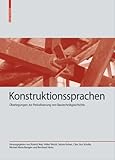Konstruktionssprachen : Überlegungen zur Periodisierung von Bautechnikgeschichte / hrsg. von Roland May, Volker Wetzk, Sabine Kuban, Clara Jiva Schulte, Michael Maria Bastgen, Bernhard Heres.
Material type: TextSeries: Kulturelle und technische Werte historischer Bauten ; 5Publisher: Basel : Birkhäuser, [2020]Copyright date: ©2020Description: 1 online resource (254 p.)Content type:
TextSeries: Kulturelle und technische Werte historischer Bauten ; 5Publisher: Basel : Birkhäuser, [2020]Copyright date: ©2020Description: 1 online resource (254 p.)Content type: - 9783035622287
- 9783035622317
- online - DeGruyter
| Item type | Current library | Call number | URL | Status | Notes | Barcode | |
|---|---|---|---|---|---|---|---|
 eBook
eBook
|
Biblioteca "Angelicum" Pont. Univ. S.Tommaso d'Aquino Nuvola online | online - DeGruyter (Browse shelf(Opens below)) | Online access | Not for loan (Accesso limitato) | Accesso per gli utenti autorizzati / Access for authorized users | (dgr)9783035622317 |
Frontmatter -- Inhalt -- Kon / struk / ti / ons / spra / chen. Eine Einführung -- Reifung und Standardisierung von Systemen aus linguistischer Sicht -- Vokabular -- The Language of English Long-Span Timber Roofs 1600–1800 -- The Russian «Language of Building Iron Roofs» Genesis and Early Dialects -- The Soul of Iron and its Revelation in Construction -- Das Zusammenspiel von Industrie, Verwaltung und Wissenschaft bei der Formierung einer Konstruktionssprache von Lagern im Eisen- und Stahlbau -- Grammatik -- The Cathedral of Girona and the Language of Equilibrium -- Baumeister und Ingenieure Konstruktives Verständnis und baupraktisches Handeln bei der Restaurierung von bedeutenden Kirchenbauwerken im 19. und 20. Jahrhundert -- Constructing, Calculating and Designing in Reinforced Concrete Towards a Common Language in Western Europe in the First Half of the 20th Century? -- Two Distinct Approaches to External Prestressing Germany and Belgium, 1930s to 1950s -- Diskurs -- Konstruktion und Konstrukt Diskursive Sprachschöpfungen im spätgotischen Gefüge -- Some Thoughts on ‹Konstruktionssprache› Versus ‹Mode of Thought -- Konstruktion und Sprache -- »Reden wir über … Konstruktionssprache!« -- Konstruktionssprachen: Ein sinnvolles Periodisierungsmodell? -- Lust auf mehr Gedanken zur Zukunft des Konstruktionssprachenmodells im Rückblick auf die Tagung
restricted access online access with authorization star
http://purl.org/coar/access_right/c_16ec
Architecture has its styles and epochs―but can the history of the underlying construction methods be subdivided into particular epochs? The volume, for the first time, investigates whether comparable historical patterns can be made out behind the facades. The focus is on the specific information conveyed to us by the loadbearing structure and construction details to help us better understand various types of buildings. In addition, the author attempts to discover whether a basic scheme of creation, consolidation, and dissolution of "construction language" can be detected beyond linear models of progression and what the potential of this approach is for a new interpretation of the history of building technology.
Die Architektur hat ihre Stilepochen – aber lässt sich die Geschichte der sie konstituierenden Baukonstruktionen periodisieren? Der Band geht erstmals der Frage, ob auch hinter den Fassaden vergleichbare zeitgebundene Ausprägungen auszumachen sind. Besonderes Augenmerk gilt dabei den spezifischen Informationen, die uns Tragwerk und konstruktives Detail zum besseren Verständnis von Objekten unterschiedlichster Bauaufgaben liefern können. Des Weiteren wird thematisiert, ob sich auch jenseits linearer Fortschrittsmodelle ein grundsätzliches Schema von Aufstieg, Konsolidierung und Auflösung von „Konstruktionssprachen" erkennen lässt und welches Potenzial diesem Ansatz für eine Neuinterpretation der Bautechnikgeschichte innewohnt.
Mode of access: Internet via World Wide Web.
In German.
Description based on online resource; title from PDF title page (publisher's Web site, viewed 26. Mai 2021)


